
28 minute read
BIZ TIPS
BOOST YOUR SUSTAINABLE EFFORTS WITH THESE THREE PSYCHOLOGICAL CONCEPTS
According to the 2020 Living Planet Index, the average global footprint per person is 2.5 global hectares. This implies we're using resources at a 1.56x quicker pace than the planet can renew, resulting in the current environmental catastrophe.
Advertisement
Individuals, governments, and corporations must all take action to address the global climate catastrophe.
This article focuses on business activity and how environmental psychology may help businesses be more sustainable. By the conclusion of this essay, you'll have a better understanding of how the human mind can influence behaviour and shift culture. You'll discover how to use this knowledge to drive company sustainability both internally (for workers) and outside (for consumers).
What does environmental psychology entail?
Environmental psychology is the study of how humans interact with and respond to the environment. An environmental psychologist, for example, could look at why people recycle, what inspires them to buy sustainable products, or what kind of surroundings make them happy.
Psychologists have long been involved in efforts to encourage long-term habits. Consider this: today's environmental concerns are a human problem, the outcome of our thoughts, feelings, and actions. What better approach to tackle this problem than to go inside the heads of people who are responsible? The climatic catastrophe is the result of a short-term survival mentality. This kind of thinking aided us 160,000 years ago, but it is less appropriate in today's world. We are building a harsher world by depleting our natural world's resources and continuing our unrestrained consumption, which is already having a detrimental influence on our well-being. Environmental psychologists research this influence as well as the human drive to reduce it.
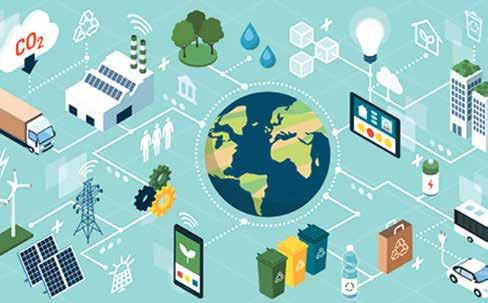
Sustainability psychology: 3 concepts to advance corporate efforts
Organizations may utilise understanding human psychology in the context of sustainability to:
• Internally, promote sustainability (aimed at employees). • Externally, market viability (aimed at consumers).
Let's have a look at three key psychological principles that are utilised to enhance both internal and external company sustainability.
Concept #1: Proactive prosocial motivations
The desire to protect and promote the well-being of others is known as prosocial motivation. Helping others for intrinsic satisfaction is self-beneficial prosocial activity.
People who are proactive in their social motivation act in ways that encourage social acceptability and camaraderie. They behave
in a way that their social group approves of. This is important.
One research, for example, attempted to minimise the energy use of a typical Canadian residence. Various messages were employed, and their efficacy was evaluated.
Messages that statistically indicated real household energy consumption were more successful in lowering consumption. This is in relation to environmental and social responsibility messaging – in this example, people decreased their energy usage to the level that a majority was said to have — unknowing that they were following societal norms (humans are not always aware of reasons for their behaviour).
Business application:
Internally, it may be used to promote sustainability: Collect and present statistics indicating employee support for sustainable development — for example, If you're establishing a cycle-to-work programme, survey your employees to see how supportive they are. Then, to attract further support, show the poll results.
Externally, promoting sustainability:
74 per cent of customers are willing to pay extra for sustainable alternatives, indicating that proactive prosocial incentives are in support of sustainable solutions. Use data like these to promote your environmentally friendly product or service.
Concept #2: Self-presentation motivation
Self-presentation refers to how people show themselves in order to influence or control how others see them. This, and other identity issues, may trump the desire to protect the environment — or, conversely, may motivate individuals to do more to save the environment.
The Toyota Prius, for example, was the world's first mass-produced gasolineelectric hybrid vehicle. Its introduction in the United States in 1997 represented an attempt to bring a practical, low-emission family automobile to the market.
The Honda Civic hybrid debuted at the same time. This was the first hybrid vehicle to receive the Advanced Technology Partial Zero-Emissions Vehicle certification. However, the Prius hampered its success.
According to a poll conducted by the New York Times, the main reason for individuals preferring the Prius over the Honda Civic is that the former's marketing efforts "make a statement about them." Individuals gained the self-perception they desired as environmentally concerned customers as a result of this.
Business application:
Internal sustainability promotion: What are the values of your employees? To promote your environmental activities, make a statement about these principles.
Externally, promote sustainability by focusing on your consumers' values. For example, most individuals want a decent quality of life for their children and future generations. Use this value to enhance longterm sustainability.
Concept #3: Behavioral affordances
Behavioural affordances are characteristics of the physical environment that allow for a certain action to be taken. Some activities that enhance sustainability, for example, are not always feasible. One such impediment is the cost.
Even when activities are physically achievable, a lack of knowledge about how to carry them out might prevent them from being carried out. The reason for acting is immaterial in either situation.
For example, when there are no garbage cans, littering is more prevalent, riding the bus is problematic due to irregular and inconsistent service, and organic fruit is unavailable.
When leaded gasoline is no longer accessible, people will switch to unleaded fuel, and they will learn to bring reusable bags when nonreusable bags are not available.
Business application:
Internally, promote sustainability: Allow employees to regulate workplace heating with programmable thermostats, for example, to make sustainable decisions simple for them.
Examine how existing sustainability-related behaviour is made simple or complex, and think about what simple modifications may be done to make it easier.
Externally, promote sustainability by making your product/service the sustainable option for your customers – for example, use less packaging. Allow customers to make an educated purchasing decision by being completely upfront about your environmental effect.
Regularly conduct environmental audits, follow ISO 14001 requirements to collect accurate environmental data, and prevent greenwashing.
Understanding human thought processes may impact the adoption of sustainable behaviours and enhance business sustainability, as seen by the three principles provided above. Consider the signals you're sending as a company and how you might improve them to empower workers and customers to generate longterm growth.

THIS IS HOW YOUR ENTREPRENEURIAL CAREER WILL PAY OFF
Did you know that for most entrepreneurs, the day they sell their firm brings in more than half of all the money they will make? It’s fantastic to be your boss, but there will come a time when you want to move on to your next adventure.
Billion-dollar software companies aren’t the only businesses being bought these days. Investors are salivating at the prospect of purchasing a company like yours. Thrasio, an Amazon company acquirer, just set a new record for the quickest unicorn, and other acquisition businesses like Boosted and Perch are snatching up well-oiled enterprises left and right. If your numbers are correct and tight, you might be on your way to a big payout.
Last year, a record amount of trademark applications were filed, indicating that more individuals are starting businesses and brands than ever before. While some of these businesses will go on to become unicorns, the majority will fail. But what about the ones in the middle who establish a great firm and then get bought out? And what do you need for your company to be appealing to investors and receive a decent offer?
EXITpreneurs are business owners who are ready to go to any length to position their company for acquisition, and they are generally energised by the bootstrap-growsell-repeat cycle. If you’re in this situation, you must understand how business valuations operate.
Business Valuation: Know How It’s Done
“Revenue is vanity, profit is sanity,” as Dave Bryant of EcomCrew puts it. In business, it’s simple to calculate top-line revenue, and these figures are frequently quoted in case studies and other fancy marketing materials.
Buyers, on the other hand, are less interested in revenue. Profit is far more important to them. Profit, on the other hand, needs a lot more effort to calculate properly. Cash flow and the seller’s discretionary profits will also be scrutinised by buyers. If you plan to sell your firm in the future, a good bookkeeper is a must-have piece of the jigsaw. When it comes to buying a firm, buyers seek four things, whether they realise it or not. These four things, which we refer to as the four pillars, are:
1. Risk
A firm that is less than three to five years old or operates in a quickly changing market is more vulnerable. This is to be expected, as investors anticipate a younger company to be more volatile. If you own a small business and want to sell it, make sure you have all of the other pillars in place so you can make a compelling argument. Risk considerations include a company’s size, age, competitiveness, and defensibility, which refers to how high a competitor’s barrier to entry is in your market.
2. Growth
Why should anyone give you their hardearned money in return for this business? Consider your value proposition carefully at this point. Consider how you can make your buyer’s life simpler after they take over the steering wheel. Although obvious measures like top-line revenue and profit margin are essential, other aspects such as transition ease are given more weight than you might expect. If you’ve identified new product SKUs that will create significant income in the future, that positioning is appealing to someone looking for a strong return on investment.
3. Transferability
A transfer of goods is referred to as a sale. Is it possible for the buyer to manage the firm in the same way that you have? The apparent problem here is firms based on a personal brand - no one else can be you, so if you’re the business, anticipate a more difficult exit and remain the name and face of the company long after it’s no longer yours. Other aspects of transferability to consider are workforce, supply chain, and workload. If you work 80 hours a week to operate your firm, a buyer is unlikely to be interested, which means they’ll have to outsource more work, increasing expense and risk. If you ever want to sell your firm, make your position as transferrable as feasible.
4. Documentation
Every entrepreneur who desires to be an EXITpreneur may get started right now. A buyer will not consider a company unless it has detailed documentation and reporting. The most crucial thing to put in place is financial paperwork, although established standard operating procedures (SOPs) and contracts are also essential. Another reason you’ll need a decent bookkeeper is that most e-commerce companies that are bought out utilise accrual accounting rather than cash accounting. Accrual accounting provides a more realistic image of actual business earnings, which is what investors will look for when deciding whether or not to purchase your company.
It may be frightening to sell a business, and many entrepreneurs miss out on one of their greatest paydays because they never execute on their exit strategy. Put these four foundations into action right now, and you’ll be on your way to a spectacular sale.

YOUR STARTUP CAN BENEFIT FROM SAYING “NO”
The word “no” has a heaviness and a negative meaning in general. We’re taught from a young age that the word “yes” — or its affirmative counterpart — is preferable. When we enter the workforce, this dualism is reinforced even more. We all want to impress our peers, management, clients, and customers, therefore it’s understandable that we want to prove ourselves.
You’re ambitious as a new entrepreneur, constantly striving to prove yourself. We strive to wear a variety of hats to acquire as much exposure and experience as feasible. We prefer to achieve this by saying “yes” to nearly every request we get.
However, as our careers progress and our businesses grow, the instinctive “yes” may lead you down a perilous path – one that will damage you more than it will benefit others. As an entrepreneur and leader, as well as a productive member of society at large, being deliberate with your time, energy, and effort, is important.
Here are three reasons why saying “no,” which is frequently frowned upon and rarely practised, may help you achieve great business outcomes.
1. You gain a distinct competitive advantage
It’s easy to fall into the trap of saying “yes” to everything whether you’re a startup or a business leader in the early stages. You want to set the road for your company’s success, and that frequently means keeping an open mind, examining your alternatives, and taking on new challenges. As a result, many young entrepreneurs are wary about saying “no.”
However, being deliberate in your use of the word “no” does not imply that you must keep yourself or your company locked off. Instead, make the most of the word “no.” It may be used to create a clear competitive proposition for your business. Use the word “no” wisely to keep yourself and your team focused on the company’s genuine goal. Saying “no” essentially implies “yes” to something else, something that is ultimately better for you and your company.
This may be accomplished by being selective in those you hire, partner with, and ultimately serve. This approach will help you stay competitive in the marketplace by allowing you to develop a clear and distinct consumer value offer. Alternatively, if you accept every offer, every candidate, and every collaboration, your company is likely to become lost in the crowd.
2. Reducing the risk of missed opportunities
The more success you have in business, the more possibilities and demands you will receive. With this comes the reality of having to make difficult choices. Is it necessary to recruit a chief of staff for your business? Are you going to approve a marketing budget increase? Will you meet with every potential customer? These are the questions you’ll have to address as an entrepreneur. If you always say “yes” in most situations, the result might be disastrous for your business. Shiny object syndrome is easy to fall prey to, but new isn’t necessarily better. For example, you could say “yes” to a good chance while passing up a better one. Of course, no one can foretell the future, but being alert, conducting due diligence, and being deliberate in what you say “yes” or “no” to may make a difference. As a successful leader, you must learn to be more discriminating. At the end of the day, greatness is the adversary of good.
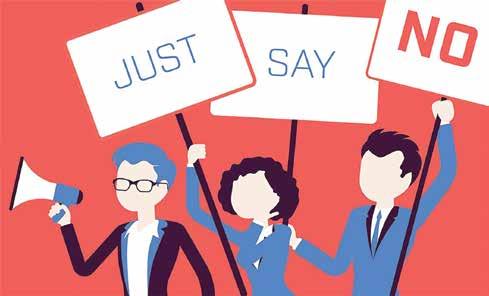
3. Clearly defines individual and professional boundaries
There’s a common misconception that becoming a successful entrepreneur necessitates making unthinkable sacrifices. You must give up everything to make your goals a reality. While you will have to make difficult decisions that will undoubtedly result in sacrifices, you should not have to sacrifice the things that are most important to you. Saying “no” is about prioritising - identifying and focusing on what matters most to you.
Let’s assume you’re leaning toward saying “yes” - what are some questions you can ask yourself to be sure you’re making the greatest option for you and your company? v Do you have the financial and time resources to answer “yes”? v If so, how much time will it take away from other, more pressing or important tasks? v Is the project appropriate for your company’s goal and, ultimately, vision? v Is answering “yes” going to jeopardise any of your company’s key values? v What are you willing to give up to work on this project or venture?
Decisions are the foundation of both business and life. A basic step you may take to carve out real entrepreneurial success is to be aware of when you say “yes” and “no.” Rewire your thinking to get rid of the negative connotation that the word “no” has. Recognize that saying “yes” in the wrong situations can have far-reaching consequences. So, what would you say the next time you have to make a crucial business decision?
CONSUMERS CRAVE FUN AND NOVELTY IN 2021
When the pandemic struck, most firms immediately adjusted their strategies. This entailed a lot of retrenchment in many businesses, such as cutting back on services or focusing on essentials for shops. So, while there was a lot of innovation in how businesses served their consumers, there was a pause in the development of new items.
According to Paul Earle, this tendency is coming to an end. Earle, an adjunct lecturer of innovation and entrepreneurship at the Kellogg School of Management with extensive experience in a new brand and business development, believes that the coming year holds a lot of promise for companies looking to innovate, thanks to a convergence of new needs, new habits, and a sense of relief and openness.
“The booming twenties followed the Spanish flu epidemic of 1918 and 1919,” he continues. “I believe we will see a tremendous desire for new experiences, for things that are enjoyable, sociable, and bring people together once again.”
What could this look like in practice? Earle offers three forecasts for the next year.
Consumers Will Want More Than Staples
Customers were searching for comfort in the early days of the epidemic, possibly as a psychological response to the terrifying prospect of a contagious illness in our midst. Well-known businesses have responded by doubling down on their core items as a result of this customer attitude. Indeed, a new study indicates that our desire for familiar items is fueled by our fear of infectious disease.
“We were concerned as an innovation community that is all about developing what's next,” Earle recalls, “because we were watching individuals walk out of Costco with enormous amounts of Scott toilet paper, Bud Light, and Kraft mac and cheese.” “These aren't exactly cuttingedge items,” he says. ‘Is it all over now?' I wondered at first. Is it safe to say that the incumbents have finally won?'
Earle, on the other hand, envisions the pendulum swinging back in 2021 when social and cultural fears fade and the COVID epidemic is contained. “We've been in a state of flux for over a year,” Earle says, “and the desire for new ideas, new experiences, new goods, new brands, new designs, new cuisine, and new home products will be resurgent.” Buying uninteresting goods in large quantities is aberrant behaviour, and that job is about to end.”He advises brands to start planning for this change immediately. “To add news and excitement to all of their different product categories, retailers need to start offering a larger selection,” he says. “The ‘same old, same old' tactic is a terrible one.”
Kindness Will Be on the Rise
Consumers will be lured to products that promise warmth and kindness, according to Earle.
“We'll see a demand for new products and services of all types that are lighter, make us smile, and connect us in new ways,” he predicts. “Through this epidemic, we've learnt that we're all in this together. We're all intertwined. And it'd be a wonderful thing if we could be as pleasant to ourselves and our neighbours as possible.” Consider last year's rush on holiday lights and Christmas trees, which happened because customers stayed close to home and wanted to do something to brighten up their relatives and friends. Some Chicago communities, for example, worked together to adorn whole blocks with festive arches.
Earle cautions against ignoring this desire for compassion as a purely sentimental act. Rather, he sees it as a potential development sector that firms should consider when developing new goods and services.
Not every new concept needs to be revolutionary. Earle and his family recently witnessed this small-bore innovation in action when they ordered Domino's pizza and the delivery person popped out a tiny cardboard platform to lay the pie close to the front door so it wouldn't get cold on the doorstep.
He says, "That's simply a wonderful idea—it probably didn't cost them much, it's simple to implement, it's a creative solution, and it just makes you grin." “People like it when businesses use their imagination to come up with novel methods to improve their
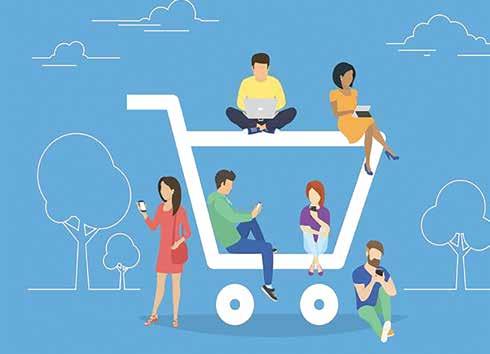

experience. I salute Domino's for providing a cardboard pizza stand. “Well done, you guys.”
Earle also predicts that in the next years, the focus on minimising waste and being a responsible member of a connected society will result in a surge of extremely functional minimalist items. Shower and bath manufacturers, for example, send tonnes of water-dense goods in single-use plastic, according to him. Earle has created a relationship with Stephanie Farsht, a Kellogg faculty member, and an R&D specialist to shift this dynamic using concentrates and recyclable packaging.
Earle adds, "We've all learned how to be more diligent and careful in what we buy, how we buy, and even how we store things at home." “We're going to be more frugal. I don't want to be a product that is large, heavy, or damaging to the environment in the future. It's tone-deaf and will seem ridiculous in retrospect.”
We Need New Solutions to New Problems
Finally, Earle expects tremendous innovation in how businesses operate and interact with customers to continue.
Earle states, “Most innovations were designed to answer a problem, typically one that the creator had personally experienced.” “Right now, people are
dealing with a lot of issues, which will lead to a lot of solutions.”
Many of these advancements are a direct result of COVID. Innovation has been happening across the economy, from the rush to develop a vaccine to revamping supply networks to distribute hundreds of millions of doses as rapidly as feasible.
“It's not just the liquid in the vial, which is a scientific miracle in and of itself,” Earle adds. “CVS now has a full refrigerator farm, which was practically built overnight to store vaccinations. It's fantastic to see how science, innovation, hard work, and entrepreneurship have all been used to tackle all of these very horrific problems.”
Aside from vaccination logistics, the pandemic has caused a major adjustment in how services are delivered. Many of these changes will be with us for a long time. For example, Earle sees the emergence of telemedicine as a necessary and long-term adaptation. While the days of cooling off in a clinic waiting room aren't gone—there are still some things physicians must perform in-person—aspects of healthcare are already being modified for a virtual future.
Companies in areas such as sports and live events are being forced to innovate as they attempt to re-engage audiences. Even if the vaccine becomes more widely accessible in the United States, there will still be several safety issues associated with large crowds.
Earle says, "Think of Wrigley Field." “The Cubs want to get folks back without causing too much traffic congestion. As a result, on their way in, they'll design quick temperature checks for fans. And there is already technology that allows drones to fly through all of the seats and clean them before the arrival of passengers.”
Earle predicts that “we'll see all kinds of innovative, creative programmes, goods, and services that we never would have imagined.” “That should make us feel good about our abilities to be resilient and inventive in the face of adversity as individuals. For an entrepreneur, every issue is an opportunity to solve.”
The Awardz is an independent award program it is an initiative by Observer Dawn
magazine. The Awardz aims to recognize and reward excellence across private, public and charity sectors. Open to organizations of any size and individuals, based anywhere in the world, entries are encouraged from those who feel they are working smarter to create a business edge. International Business Awards (IBA), The Indian Realty Awards (IRA), and Pride Awards (PA) bring together the most successful and influential visionaries, manufacturers, consumer and business experts and the industry’s powerful decision-makers on one mega platform as a means to Indian Business enlightenment.

Visit www.theawardz.com
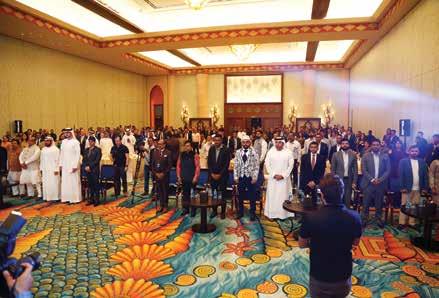
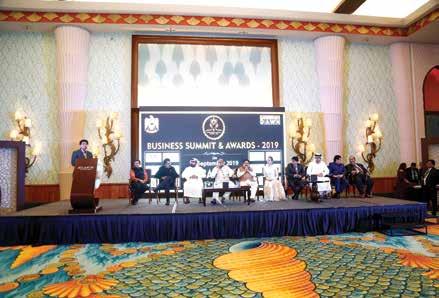
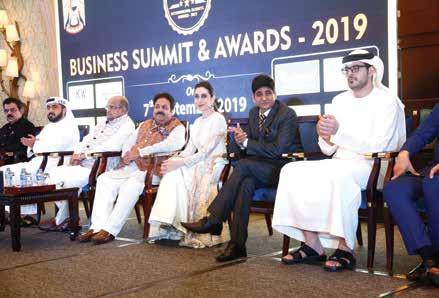



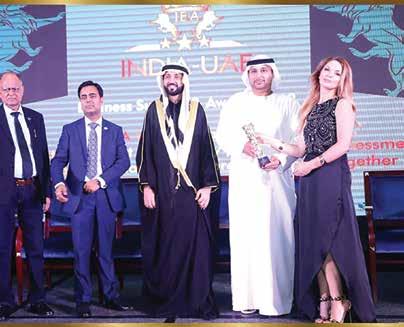
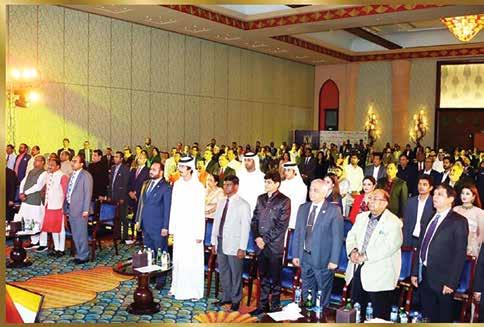
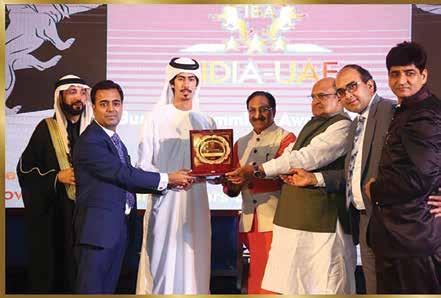
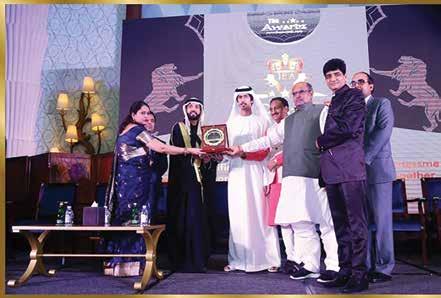

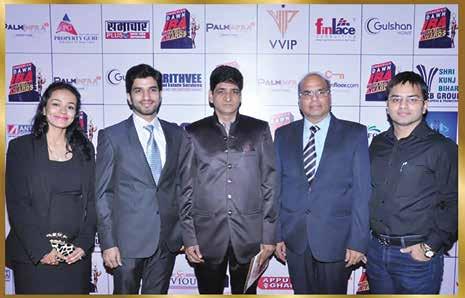
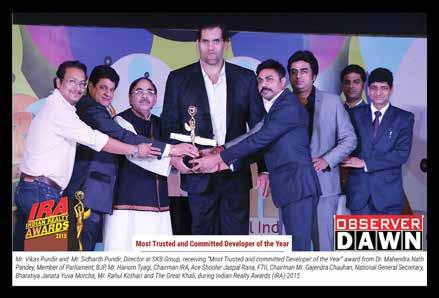
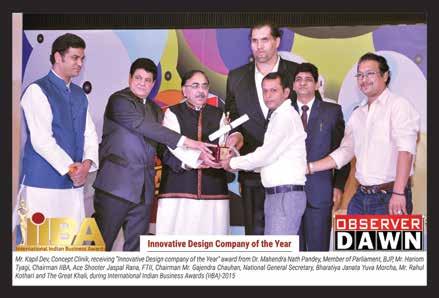
Thermal generation has remained the mainstay of India’s power mix for past many decades. Out of the total installed capacity of 386 GW in July 2021, Thermal projects form 61 per cent of the overall installed capacity, followed by 25 per cent from renewable projects, 12 per cent by hydro projects and about 2 per cent from the nuclear projects.

TRANSITION TOWARDS RENEWABLE SECTOR
HIMANSHU SINGH - Assistant Manager Power Finance Corporation Ltd
The history of human evolution rest on the availability and use of energy. It is the basis of all the fundamental things like lighting, cooling, heating, etc. Today, electricity consumption can also help unravel the trends of growth in a country.
India being a growing economy has witnessed growth in Electricity demand over the past few decades. The per capita consumption of electricity has increased from 805 KWhr in 2014 to 1208 Kwhr in 2019. It can be seen against the world average of 3018 KWhr in 2019, which signify a large scope of growth in the years to come.
Thermal generation has remained the mainstay of India’s power mix for past many decades. Out of the total installed capacity of 386 GW in July 2021, Thermal projects form 61 per cent of the overall installed capacity, followed by 25 per cent from renewable projects, 12 per cent by hydro projects and about 2 per cent from the nuclear projects.
India recognizesthe threatof having such large dependence on thermal projects including the emission of Green House Gases (GHGs) and its potential impact on climate change. India has therefore set itself an ambitious target for the Intended Nationally Determined Contributions (INDC), for committing to the Paris agreement, which includes:
• 40 per cent of its total electricity generation from non-fossil fuel sources by 2030 • reduce the emissions intensity of its GDP by 33-35 percent by 2030, below 2005 levels • additional carbon sink of 2.5 to 3 billion tonnes of CO2 through additional forests by 2030 For achieving these targets, India has set a target of setting up 175 GW by 2022 of which it has achieved approximately 100 GW. The government has also increased the target to 450 GW by 2030. A transition to renewables from fossil helps has linkage with other sector too.
Shift to renewables also help save coal imports. Last year, coal worth INR 1.71 lakh Crore was imported which could be saved. Additionally, India has nearly 29 per cent or 96.40 million hectare degraded land which is not fertile. It can be utilized for setting up renewable projects. This is true for states like Rajasthan where terrain makes setting up other industries difficult but are rich in renewable resources.In the transportation sector, shift to electric vehicle reduce the dependence of the country to the imported crude oil and help attain self-sufficiency in the energy.
In the agriculture sector, shift from diesel pumps to solar pumps can help reduce emission, improve viability of the distribution companies, a decentralized grid connection to these can provide an alternative income to the farmers. PMKisan Urja Suraksha evamUtthaanMahabhiyan (KUSUM) schemeaims to add decentralized solar power production of 30.8 MW by 2022 and install two million standalone solar powered agriculture pumps.
Thetransition is driven by some inherent advantages of renewables. The variable cost of the plant is zero as they do not require any fuel to run. The fixed cost is also decreasing owing to improvement of technologies which improves capacity utilizing factor and economies of scale. Further, solar power plants have few moving parts leading to lower mechanical wear and tear and hence lower

operational and maintenance costs. Wind power plants require less land to operate. Biomass and MSW power plants solve the problem of urban waste management as well as electricity.
The government has greatly incentivized renewable energy. The support includes waiving off of interstate transmission system tariff, giving mustrun status to renewable projects, Renewable purchase obligation, Carbon trading mechanism, etc.
Also, renewable projects are able to achieve financial Closure relatively simpler than conventional projects considering their short gestation period, tier up power sale arrangements, smaller debt requirements as compared to conventional projects and also availability of funds from internal markets. Among the various instruments, green bonds has been a popular way for financing renewable power projects. Green bond was first issued by Yes Bank in 2015 and steadily increasing to overall capital mix of the companies owing to lower rates. In Feb 2020, the total outstanding green bond was 16 billion USD. Other than green bonds, Banks and NBFC provides loans. PFC, REC, IREDA, SBI, etc, has a presence across the value chain of renewables. PFC has supported renewables with loans of INR 37,000 Crore as of 31st March 2021.
However the transition is far from complete. Despite, renewable projects contributing about 25 per cent of India’s installed capacity, the actual contribution of the renewables in the energy market is approx. 8 per cent of the peak capacity.
This is primarily due to intermittencyin generation. This creates a problem as the energy generated is dependent on the external weather scenario. This is valid especially for solar and wind projects where energy fluctuation is daily and also seasonal in nature respectively. This also create problem grid stabilization.
Also, domestic manufacturing of the equipment is not present leading to a lack of integration in the value chain. India does not have large Research and development investmentand equipment is typically imported. According to the Standing committee on Energy LS- 2019-20, India imported solar wafers, cells, modules, and inverters worth USD 2.5 billion.To ensure the mass adoption of renewables one has to solve the above challenges. The problem of intermittency and grid stabilisation can be tackled by battery storage, hybrid plants and renewable energy corridor. Research on new battery technologies like lithium-sulfur, solid-state batteries, air-cooled batteries etc. is underway globally. In India, industry is investing in this space with Reliance Industries acquisition of US-based energy storage startup Ambri, TATA power has commissioned 10 MW battery storage plant in Delhi. Further, TATA power is setting up battery storage of 50 MWhr in Leh. Government of India is also planning to set up energy storage at regional load dispatch centers.
Hybrid plants like solar hydro, wind hydro, wind solar, etc. are coming up. Construction of 30 GW wind solar plant in kutch, Gujrat started recently. Moreover, green energy corridor which aims at synchronizing electricity produced from renewable sources, like solar, wind, etc. Nearly 6258 km of transmission lines have been constructed.
For making an integrated environment, setting up of domestic module manufacturing unit is an imperative. AtamNirbhar Bharat program has given impetus to the manufacturing of power equipment. Government has introduced Production Linked Incentive scheme where it plans to spend INR 4,500 Crore to add capacity of 10 GW of integrated solar panel manufacturing.
Renewables is a still a nascent technology. Different forms of renewables are in development stage globally. Concepts like decentralized solar which helps charge the electric vehicles which can inturn power small grid is being tested. Grid level battery packs are underpilot program. Green hydrogen technology is starting to find usage in transport, heating in UK, USA, etc.
The government has taken steps in this regards. Rooftop Solar target of 40 GW by 2022 is being envisaged in National Solar Mission. For the movement towards electric vehicle INR 10,000 Crore allocation to the FAME-II scheme is being made. National Hydrogen Mission is being announced to emphasis on Research and development and use cases in fertilizer industry and petrol and refining.
Renewables would basis for achieving sustainable development, preventing climate change, building self-sufficiency in energy. Thus, transition is not a choice but a necessity.









